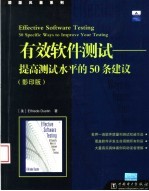

有效软件测试 提高测试水平的50条建议 影印版PDF电子书下载
- 电子书积分:11 积分如何计算积分?
- 作 者:(美)达斯汀著
- 出 版 社:北京:中国电力出版社
- 出版年份:2004
- ISBN:7508310543
- 页数:258 页
1.Requirements Phase 1
Item 1:Involve Testers from the Beginning 3
Item 2:Verify the Requirements 5
Item 3:Design Test Procedures As Soon As Requirements Are Available 11
Item 4:Ensure That Requirement Changes Are Communicated 15
Item 5:Beware of Developing and Testing Based on an Existing System 19
2.Test Planning 23
Item 6:Understand the Task At Hand and the Related Testing Goal 25
Item 7:Consider the Risks 31
Item 8:Base Testing Efforts on a Prioritized Feature Schedule 39
Item 9:Keep Software Issues in Mind 41
Item 10:Acquire Effective Test Data 43
Item 11:Plan the Test Environment 47
Item 12:Estimate Test Preparation and Execution Time 51
3.The Testing Team 63
Item 13:Define Roles and Responsibilities 65
Item 14:Require a Mixture of Testing Skills,Subject-Matter Expertise,and Experience 75
Item 15:Evaluate the Tester's Effectiveness 79
4.The System Architecture 91
Item 16:Understand the Architecture and Underlying Components 93
Item 17:Verify That the System Supports Testability 97
Item 18:Use Logging to Increase System Testability 99
Item 19:Verify That the System Supports Debug and Release Execution Modes 103
5.Test Design and Documentation 107
Item 20:Divide and Conquer 109
Item 21:Mandate the Use of a Test-Procedure Template and Other Test-Design Standards 115
Item 22:Derive Effective Test Cases from Requirements 121
Item 23:Treat Test Procedures As"Living"Documents 125
Item 24:Utilize System Design and Prototypes 127
Item 25:Use Proven Testing Techniques when Designing Test-Case Scenarios 129
Item 26:Avoid Including Constraints and Detailed Data Elements within Test Procedures 135
Item 27:Apply Exploratory Testing 139
6.Unit Testing 143
Item 28:Structure the Development Approach to Support Effective Unit Testing 145
Item 29:Develop Unit Tests in Parallel or Before the Implementation 151
Item 30:Make Unit-Test Execution Part of the Build Process 155
7.Automated Testing Tools 159
Item 31:Know the Different Types of Testing-Support Tools 161
Item 32:Consider Building a Tool Instead of Buying One 167
Item 33:Know the Impact of Automated Tools on the Testing Effort 171
Item 34:Focus on the Needs of Your Organization 177
Item35:Test the Tools on an Application Prototype 183
8.Automated Testing:Selected Best Practices 185
Item 36:Do Not Rely Solely on Capture/Playback 187
Item 37:Develop a Test Harness When Necessary 191
Item 38:Use Proven Test-Script Development Techniques 197
Item 39:Automate Regression Tests When Feasible 201
Item 40:Implement Automated Builds and Smoke Tests 207
9.Nonfunctional Testing 211
Item 41:Do Not Make Nonfunctional Testing an Afterthought 213
Item 42:Conduct Performance Testing with Production-Sized Databases 217
Item 43:Tailor Usability Tests to the Intended Audience 221
Item 44:Consider All Aspects of Security,for Specific Requirements and System-Wide 225
Item 45:Investigate the System's Implementation To Plan for Concurrency Tests 229
Item 46:Set Up an Efficient Environment for Compatibility Testing 235
10.Managing Test Execution 239
Item 47:Clearly Define the Beginning and End of the Test-Execution Cycle 241
Item 48:Isolate the Test Environment from the Development Environment 245
Item 49:Implement a Defect-Tracking Life Cycle 247
Item 50:Track the Execution of the Testing Program 255
- 《软件工程》齐治昌,谭庆平,宁洪编著 2019
- 《土壤环境监测前沿分析测试方法研究》中国环境监测总站编著 2018
- 《微笑 影印本》N.达列基作 1947
- 《小学语文阅读提分训练 二年级》陈玲编著 2012
- 《计算机自适应英语语用能力测试系统设计与效度验证 以TEM4词汇与语法题为例》张一鑫著 2019
- 《金丝髪 侦探小说 影印本》格离痕著 1914
- 《高中压配电网规划 实用模型、方法、软件和应用 上》王主丁著 2020
- 《无机及分析测试技术》李巍巍 2018
- 《汉语口语测试评分员评价研究》黄霆玮著 2019
- 《小学语文阅读提分训练 一年级》任琨编著 2012
- 《中国当代乡土小说文库 本乡本土》(中国)刘玉堂 2019
- 《异质性条件下技术创新最优市场结构研究 以中国高技术产业为例》千慧雄 2019
- 《中国铁路人 第三届现实主义网络文学征文大赛一等奖》恒传录著 2019
- 《莼江曲谱 2 中国昆曲博物馆藏稀见昆剧手抄曲谱汇编之一》郭腊梅主编;孙伊婷副主编;孙文明,孙伊婷编委;中国昆曲博物馆编 2018
- 《中国制造业绿色供应链发展研究报告》中国电子信息产业发展研究院 2019
- 《中国陈设艺术史》赵囡囡著 2019
- 《指向核心素养 北京十一学校名师教学设计 英语 七年级 上 配人教版》周志英总主编 2019
- 《《走近科学》精选丛书 中国UFO悬案调查》郭之文 2019
- 《清至民国中国西北戏剧经典唱段汇辑 第8卷》孔令纪 2018
- 《北京生态环境保护》《北京环境保护丛书》编委会编著 2018
